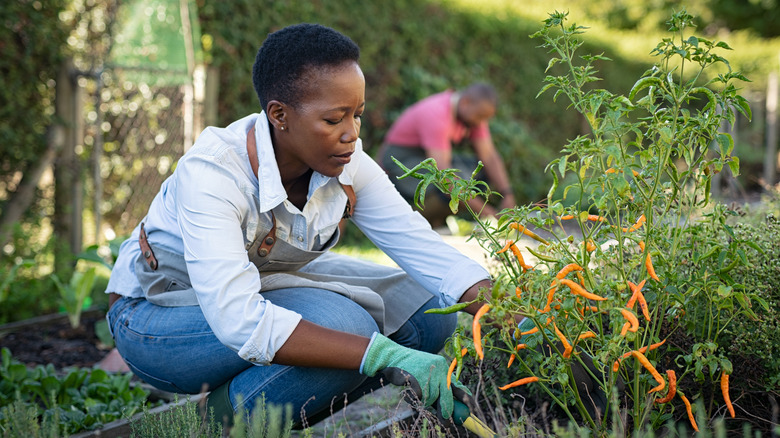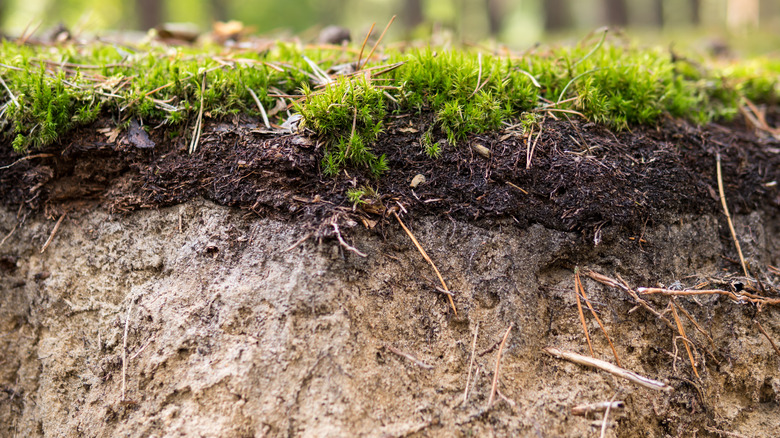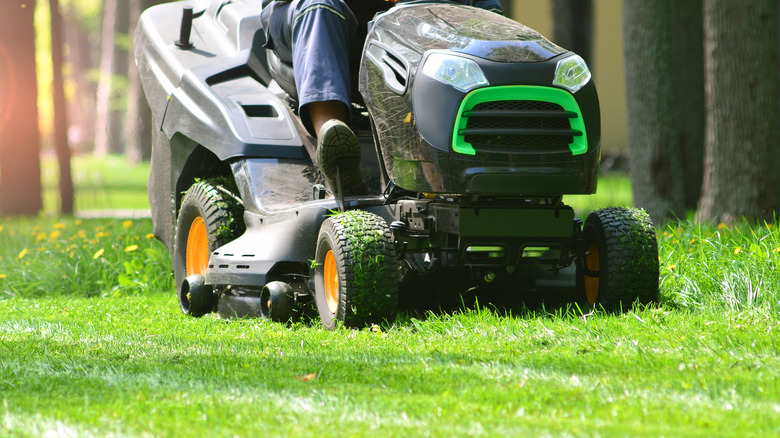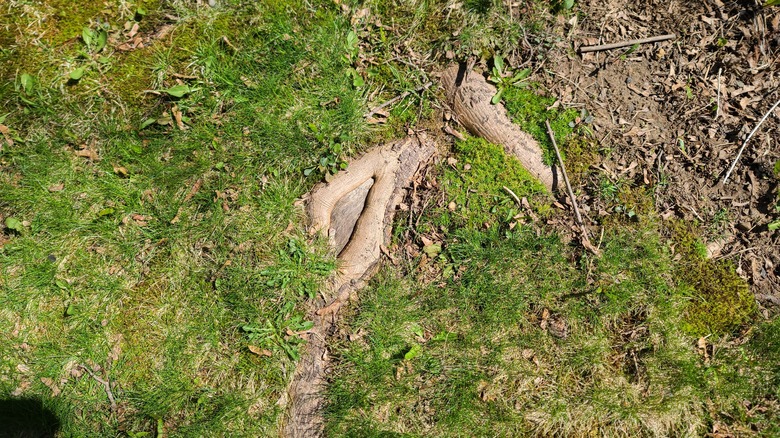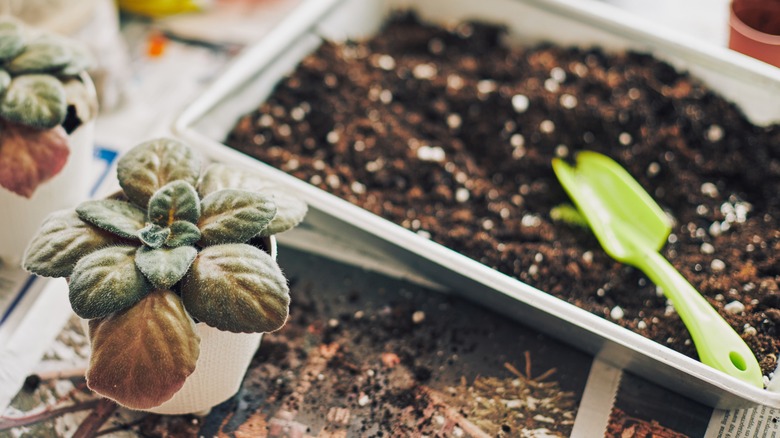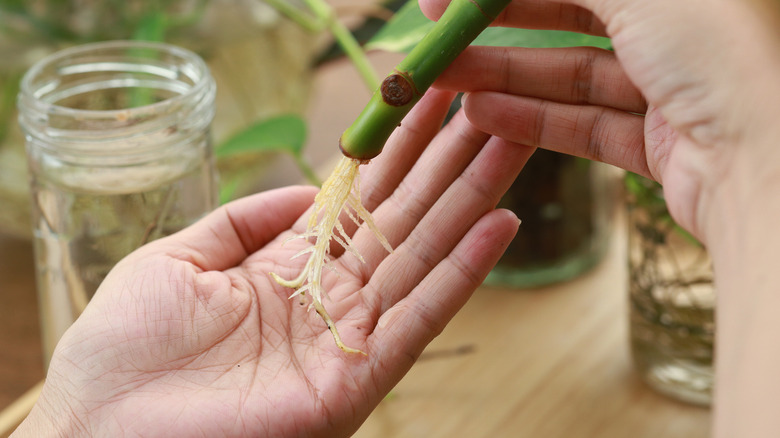5 Clever Ways To Use Sand In Your Lawn And Garden
Sand is not just for beaches, and although it's not as popular in residential uses, using sand as a top dressing is very popular on golf courses, according to LawnEQ. Since golf courses are known for their flawless grass, you might be wondering if you should also start using sand, too. After all, it's affordable and easy to find in almost any garden center. But using sand isn't as simple as it sounds, and it's not always the best solution for every lawn.
It may come as a surprise to learn that sand can be used in many ways around the home, garden, and lawn. Below are all the ways you can use this material to improve the health of all the plants around your home. Just be sure you're using builders sand, not play sand or beach sand. Sometimes it's even recommended to sanitize the sand before using it in your gardening to ensure there are no bugs or germs that could harm your plants.
1. Add it to clay heavy topsoil
Although some claim that adding sand to your topsoil is a good idea, that isn't always the case. Often adding sand to your topsoil can harm the health of your lawn rather than improve it. The reason golf courses can use it so much with success is their ability to maintain and care for the lawn daily. It's likely that while you probably water, mow, and seed your garden; you don't have the time to fertilize, trim, and care for the grass as they do.
However, if you live in an area where the soil is filled with clay, adding sand to your topsoil can be beneficial to the health of your soil and the grass you're trying to grow (via DIYS.com). It will bring good drainage where there was soggy moss, allowing the roots to dig deeper to find the nutrients they need. Just be sure not to overdo it, or you'll risk suffocating your grass and killing it. A light sprinkle can go a long way, or if you're seeding new grass over bare ground, mix the sand into the topsoil with a tiller or rake before seeding.
2. Use it to even out bumps
If you use a riding mower to cut your grass and you find that your brain feels like scrambled eggs after riding over the bumpy lawn, you might want to consider using sand to even out the bumps. Sand is the perfect tool to use to combat this common issue, according to Greener Lawn. Whether these dips in the yard come from mole tunnels collapsing, trees being removed, or a dog that can't stop digging, they're annoying. It can even make it hard to use a push mower and make an already physically intense chore even harder.
Next time you're at the local garden center, grab yourself a bag on builders sand. You can use this to fill in the holes. Since the sand is heavy and fine, it will make the transition from sand to soil smooth, and the grass will quickly take back over the sand — no more headaches after cutting the grass or twisting your ankle while throwing a ball for the dog.
3. Save exposed tree roots
That giant tree in the yard is stunning and offers fantastic shade, but its roots could be too close to the surface. Sometimes roots like this can even grow so tall from the ground that the lawn mower starts to catch on them. This is terrible for your mower blades and the health of the tree. Getting cut like that causes a wound on the root that makes it more susceptible to disease and rot. Eventually, this could kill the tree.
To protect the roots and your mower, you can use an equal mixture of sand and soil (via LawnEQ). Slowly build up a layer to completely cover the roots, and keep going until there are about 3 to 4 inches of soil between the surface and the roots. The grass will grow back over the new topsoil, and now your tree roots are protected. The sand makes this mixture heavy enough to stay put but also allows for excellent drainage and aeration.
4. Mix it with soil for multiple uses
The additives you have to buy to create soil mixes can be expensive, but you can replace some of them with sand. For example, houseplants are locked in a small pot instead of in the ground. This makes them susceptible to root rot if the soil they're in doesn't have good enough drainage. According to Tiny Garden Habit, adding sand to potting soil mixes can fight this battle, and it's less messy than perlite. You also don't have those ugly white specs at the top of your soil when you use sand versus perlite.
Additionally, sand can be used in landscaping to help fight erosion. Often our landscaping is on hills, dips, or close to downspouts where lots of water flows past. You can use sand mixed with your topsoil to strengthen the area and lessen the effects of erosion. This protects the plants around the area from losing all the precious soil around their roots.
5. Propagate plant cuttings in it
If you have a lot of houseplants, you've likely spent an afternoon trimming and pruning them. In the end, you have a pile of leaves that sometimes are perfectly healthy, and you could grow new baby plants with them. However, if you use a container and propagate with water, you risk the new plant having trouble acclimating back to the soil once the roots have started to grow. Also, not all plants can propagate in water and soil. However, when you use soil to propagate, it can be hard to know if the cutting is doing well or growing roots because you can't see them. And the soil doesn't move easily enough to pull the plant out without risking breaking the new roots.
Instead, use sand. Sand is the perfect option for propagating cuttings because it holds moisture without suffocating the plant (via Tiny Garden Habit). It'll also be much easier to transition the plant from sand to soil. Lastly, checking on the roots is more accessible in sand as well because the sand will gently fall away, so you can see just how much progress the little roots have made.
